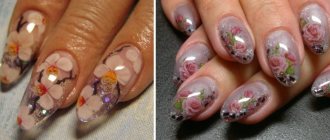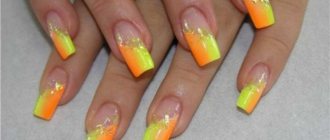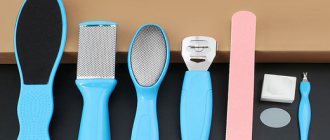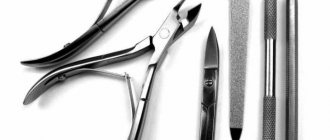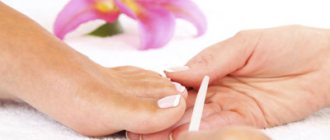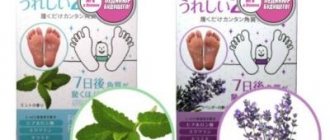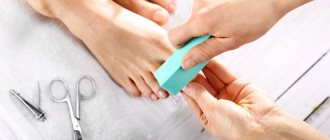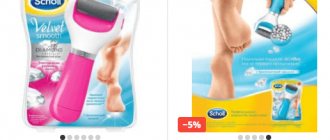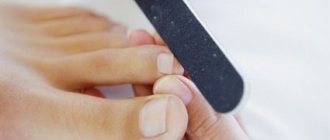First acquaintance with the machine
Among the powerful arsenal of a pedicure master, there are many tools. For hardware pedicure - your own, and for trimming - your own professional kits. For the latter type of manicure, using a machine is common. This item is minimally similar in appearance to its comrade of the same name - a razor, but they still have common components:
- comfortable handle;
- blade holder head (usually made of stainless steel);
- blade (replaceable sharp nozzle).
This simple design is intended specifically for pedicures; the machine is not used on other parts of the body. The razor blade is replaceable, which allows you to easily change it and always use a sharp unit.
The working surface of the product (head with blade) is one-sided, that is, one side is curved so as to touch areas of the skin of the feet with problems and cut them off with the blade. The second side does not perform any functions.
Advantages and disadvantages
The choice of specific items for work is a personal matter for each master, but taking into account the wishes of the client. If you chose a trimmed pedicure out of ignorance, then you can’t do without a machine. Clients attending the procedure are horrified by the appearance of the machine, preferring abrasive files or milling cutters. The machine is indeed a little intimidating, especially if you have no experience of using it before.
Like any other tool, a pedicure machine has both advantages and “sins”. Among the strengths of the device are:
- simultaneous cutting of a large part of the roughness;
- in a couple of procedures, you can achieve an ideal result;
- low cost of such pedicure procedures.
The biggest disadvantage of using a pedicure machine is the possibility of cuts. Through them you can easily introduce an infection or fungus. This trouble usually occurs with newcomers to the business. Professional specialists perform this foot treatment carefully and painlessly. The procedure also requires timely repetition to avoid new, rougher areas of the skin.
How to use at home: step-by-step instructions
Professional tools can be found not only in beauty salons. You can purchase them at any cosmetic store and remove rough skin yourself. After all, the pedicure machine can also be used for home use. This will not only save time on going to the salon, but will also save your budget.
In order to use the machine safely, without the risk of cuts, it is necessary to follow certain rules for performing a trim pedicure. You cannot use a regular razor during the procedure. Classic pedicure involves careful preparation of the feet:
- Wash off all dirt from your feet with soap and water. This is necessary so that during the following manipulations the dirt does not spread over the entire area of the foot.
- Steam your feet up to your ankles in warm water (recommended temperature is 40-45 degrees). It is advisable to add some kind of antiseptic (for example, hydrogen peroxide) to the water.
The procedure takes up to 30 minutes, it all depends on the layer of keratinized skin. As the water gradually cools, it must be replenished with hot water. To do this, it is better to immediately place a bowl of hot water next to you so as not to be distracted from steaming your feet.
Preparing for a pedicure using steaming
An alternative to steaming is wrapping. To do this, use gauze napkins and laundry soap. Feet are washed under running water and lightly dried with a towel. Next, hands are intensively soaped, the resulting slurry is applied to rough skin, gauze napkins are soaked in it and also placed on these areas. It is necessary to wrap a stretch film over such compresses, fixing the gauze napkins well. You need to wait about half an hour, after which you can trim the roughness.
Preparing for a pedicure using the wrap method
If necessary, use special baths with tincture of marigolds (calendula), chamomile, a decoction of string, salt, and soda. Next, you should find out the problem areas on your feet. Most often these are the edges of the heels, the side of the sole near the little toe, under the phalanx of the big toe, between the big and second toes, on the sole in the toe area, etc. Having determined the necessary areas for processing, the tool itself is used:
- Turn the machine with the protruding blade facing the skin.
- Remove the top layer of rough skin from the feet using a machine. For safe removal, this should be done slowly, in the direction from the edge to the central part of the heel (but not vice versa). It is also not recommended to move the blade of the machine along the edge of the heel. Only rough areas should be treated, without touching healthy skin. If, after using the machine, even stripes remain on the skin, then the procedure is proceeding correctly. The machine can be used several times over the same area.
- To complete the pedicure, treat the cuticle with a pedicure tool and remove it with special nippers. Cuticle removal can also be done with another convenient tool (nail scissors, nail clippers, styler). It is forbidden to remove cuticles with a machine. Such manipulations will result in injuries to the skin and nails.
- Complete sanding of the skin is carried out with a regular sanding file or an electric pedicure machine.
- After completing the pedicure, the feet are nourished with cream.
It is advisable to wear warm socks after the procedure, and a day later do paraffin therapy. Such sessions will need to be carried out at least once every two weeks, since the skin will quickly regenerate and provoke the appearance of new rough layers.
Wooden and Teflon nail files
Wooden and Teflon tools are often used by craftsmen in beauty salons. Files made from such materials work with natural and false nails. The catalog contains files of various shapes and grain sizes, as well as disposable tools. Files made of wood and Teflon are multifunctional. They are used for:
- grinding and polishing the nail plate;
- filing;
- cleansing the skin of the feet;
- cuticle processing.
Glass
Instruments made of glass and crystal are intended for home and salon use. They protect the edge of the nail plate from delamination, are durable, and do not lead to the appearance of microcracks. The catalog contains glass files of various colors, shapes, and abrasives.
Ceramics
Ceramic tools are used to process natural and false nails. These tools are used to process the cut in two directions, as they do not leave microcracks or cause delamination of the nail plate.
Mylar
Polymer material invented by Du Pont. Durable, lightweight, hygienic Mylar is coated in a variety of grain sizes.
Abrasive material
Popular files with abrasive made from precious stones:
- diamond;
- sapphire;
- ruby.
These are hard materials designed to handle durable nails. Tools with an emery working surface do not go out of use. The sandpaper is designed for soft nails.
Replacement attachments for pedicure equipment have different shapes and grain sizes. The 1-TOUCH company offers sets of 10, 40, 50, 60 nozzles. The company's catalog presents products of foreign companies and goods of its own manufacture.
Tips for using a pedicure machine
It is not recommended to use a pedicure machine for severe corns with cracks. In this case, it is better to remove some of the roughness with an abrasive, and then carefully use the machine. If blood appears, the procedure must be stopped and the damaged area treated with an antiseptic.
If there were intense, rough layers of skin on the feet, then one procedure may not be enough to achieve an ideal result. You should repeat the pedicure after 10 days. Between sessions, you can maintain the condition of the skin of your feet with a simple pumice stone or an abrasive file.
The machine is suitable for use on dry calluses. But when using a tool to remove dry skin, there is a high probability that the blade will penetrate deeply, making it easy to get a cut. Therefore, beginners in the pedicure business should not do this.
A razor used to remove hair from the body should not be used to remove rough skin. The shaving machine is not designed for this and can cut the skin.
In order for your favorite machine to last as long as possible, it needs care. It consists of timely cleaning and disinfection. To clean it well, just disassemble it and rinse it in a soapy solution. After drying, collect it. The product can be disinfected with an alcohol wipe or by boiling (an alternative is an ultraviolet sterilizer).
What types of heel cleaning devices are there?
To care for your heels, you can now purchase various devices that greatly facilitate the process of cleaning keratinized areas. The most popular of them are the electric pumice stone and the foot file. Let's look at each device in more detail.
- Electric pumice is a machine for cleaning, polishing and massaging heels. Manufacturers promise that as a result of regular treatment with electric pumice, your heels will become soft and smooth, like a child’s. The kit usually includes several different attachments - for intensive cleaning of heels, for gentle peeling and for grinding. The device carefully separates particles of the stratum corneum and collects them in a special container, so during the procedure you keep the workplace clean. However, you can find controversial reviews online. Many women who have tested this device claim that it is only good for final polishing, and in advanced cases it does not give much effect.
- An electric file is another device that is designed for heel care. Previously, before the advent of such devices, people resorted to using a regular razor, cutting off a layer of rough skin. This is a fairly effective, but unsafe procedure, during which you can easily get injured. With an electric file, the cleaning method has become much more effective and safer. The compact device easily, quickly, painlessly and efficiently removes calluses, corns, and a thick layer of overgrown epidermis from the heels. This pedicure novelty copes with the most neglected condition of the feet.
Tips for choosing: review of popular brands
When you decide to purchase a pedicure machine, you can make a lot of mistakes when choosing. The main mistake is the choice of low-quality base material for attaching the blade. Stainless steel is the best option for choosing a machine head. Having chosen a material that is susceptible to rust, over time it will become covered with traces of it and this will become an obstacle to tightly fixing the blade. This will negatively affect the functionality of the machine.
Replacement blades should also be selected from stainless steel. They will not succumb to corrosion and will last a long time.
Staleks
Professional tools of this brand have a comfortable handle, and stainless steel is used to produce the product. The shape of the tool is “hatchet”. The machine from Stalex is suitable for removing rough layers of skin “dry” and for steamed feet.
Titania
This amazing machine from a European manufacturer has a fairly low cost and does not require blade replacement. The Titania machine consists of a stainless head and a comfortable plastic handle. Removes rough layers of skin layer by layer in even strips. It is more effective when used on steamed skin.
Better
The European brand offers a Beauty Care machine, which comes with replacement blades. The machine has a stainless steel head, but the ergonomic handle is made of plastic. The tool is intended for removing roughness from dry and steamed skin. The blades in this machine need to be changed depending on the dullness.
Zauber
A good pedicure tool with code number 05-999 is made entirely of stainless steel. The manufacturer uses titanium blades that do not require sharpening. The tool copes well with already prepared, steamed skin, as well as with dry, rough areas of the feet.
Olton
A professional machine made of medical steel. Can also be used at home. It requires careful care in the form of cleaning and sterilization. Copes with various roughness on the feet and removes them painlessly.
Electric pumice stone for feet: features
- Electric pumice helps to quickly remove corns and calluses at home. This device is completely safe and does not harm the skin. The cleaning effect with electric pumice is excellent. The skin of the feet becomes smooth and soft, just like after cleansing in a salon.
- Electric heel cleaning can be used both to remove a small amount of rough skin and in advanced cases when there are large corns and calluses. In the latter case, it must be carried out in several sessions.
- Electric pumice is a multifunctional device. The device comes with several attachments: for removing calluses, soft and rough cleaning of heels, and polishing the skin. As a rule, such pumice stones are compact, which allows you to take them with you when traveling.
- The device is also convenient because you can change the speed. Most electric pumice stones have 2 speed settings. The first one is used when there are no serious corns, and you just need to regularly clean your feet of dead cells. 2nd speed does a deeper cleansing. It is advisable to use it to clean large corns and get rid of calluses.
- Before using the device, you need to make a foot bath and dry them thoroughly with a towel. After the procedure, it is recommended to apply a rich cream to the skin of the feet.
